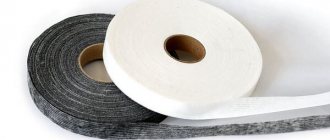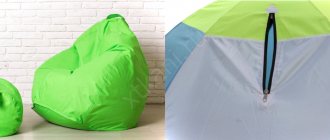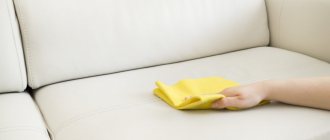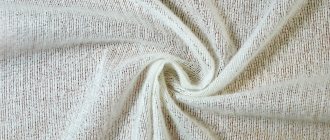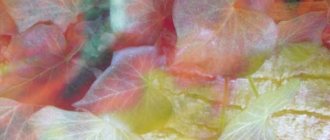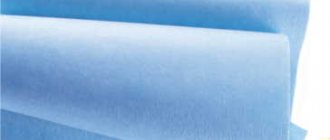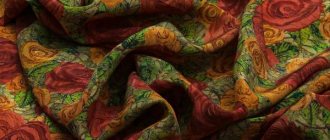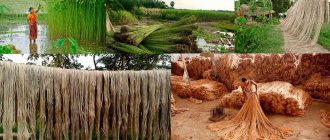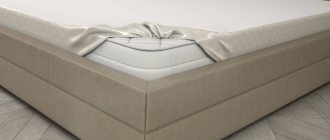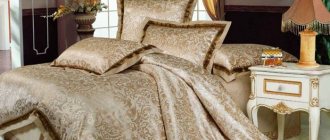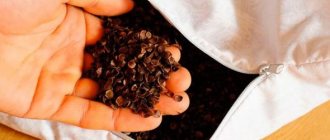Why are cushioning materials needed?
In the manufacture of clothing, a huge role is played by interlining materials, which are placed between the main fabric and the lining, hence the name - interlining. There are three main functions of the gasket:
- Giving and maintaining the shape of individual clothing parts. Not a single classic jacket or coat is complete without duplicating materials. They are used to glue shelves, edges, lapels, cuffs, collars, belts, pocket flaps, leaves. Shoulder pads and sill pads are also used to give shape.
- Increases wear resistance and protects parts from stretching. Some areas of the product experience heavy loads, such as fasteners, pockets, vents, and necklines. Therefore, these places must be duplicated - the zipper allowance, trims on shirts and blouses, neck cuts, facings, pocket entrances.
- Protection from wind and low temperatures. If you decide to sew a winter coat or jacket, in this case you will need insulating materials: batting, padding polyester, down, wool, which are used to duplicate or stuff the product.
How to properly glue adhesive fabric with an iron
- Before cutting, the thermal fabric must be decated. Just spray it with water from a spray bottle, lay it on a flat surface and let it dry. If this is not done, after the first wash it may shrink, then the item will warp and wrinkles will form on it.
- When cutting, the direction of the grain thread is taken into account; it must coincide with that of the main fabric. There is no seam allowance, it is simply not needed, and if it is made, the edge (seam) will be denser and more voluminous.
- The part is applied to the workpiece (clothing part) with the rough side to the wrong side, pressed with an iron heated to 100 degrees. If the surface area is large, every centimeter of it should be pressed with a delay of several seconds. The glue melts and sets, the parts can no longer be separated from each other.
You can clearly see how to glue fabric to fabric with an iron in the video.
Types of cushioning materials
There is a large amount of duplicate material. Sometimes several types of pads can be used in one product; this applies to men's jackets, cardigans and coats. Spacer sheets can be adhesive or non-adhesive . Adhesive ones are made by applying special glue on one or both sides. Depending on the method of application, the adhesive layer is of two types: dotted and continuous.
There are also three types of base on which glue is applied: woven , non-woven and knitted . The fabric base has a grain thread, which must be taken into account when cutting parts. These types of pads are also called thermal fabric. The non-woven base is a pressed mixture of fibers that does not have a specific direction. Knitted backing fabrics are used for sizing knitwear products to maintain the elasticity of the materials and at the same time give them shape.
Let's look at the most common types of duplicating materials separately.
Application area
Many people don’t even know what non-woven fabric is needed for. And this is despite the fact that the scope of its application today is very extensive. When purchasing clothes or some other textile, most buyers are not aware of the presence of such fabric inside the product itself. With its help they duplicate:
- linings, edges, seams in jackets or coats;
- belts, collars, cuffs, flaps of trouser pockets, dresses, shirts.
It is difficult to do without such a substrate in the process of making high-quality soft toys and various accessories. In modern needlework, a special cushioning fabric is used: it dissolves easily after the first wash and has extremely convenient markings applied to it.
In addition to the textile industry, non-woven backing is widely used in the manufacture of finishing products in construction. Additionally, water-soluble non-woven fabric is used in medicine instead of conventional dressing material.
Non-woven wallpaper - a coating consisting of two layers: a decorative top layer and a non-woven backing Source images.ua.prom.st
Crinoline
The collar has a fabric base. The composition can be natural (cotton, linen, wool, horse and camel hair), artificial and mixed. This is a dense fabric that is used primarily in the manufacture of men's jackets and coats. There is also a distinction between adhesive and non-adhesive fabric. The adhesive-coated edging is glued to the main parts using an iron; non-adhesive edging is quilted by hand. The traditional technique for making elite men's jackets involves up to five layers of edging, which is sewn with a fine stitch by hand. In mass production and budget studios, side fabric with an adhesive coating is used.
History of appearance and production
The technology for making nonwovens dates back to the 1930s. The first fabric of this type was produced in Europe by combining viscose fibers with chemicals. The innovator was the French company A. Thibeau & Cie. She also created the first machine for making viscose threads. They served as the basis for non-woven fabrics and were connected with special resins.
Until now, France is a leading manufacturer of equipment for the production of nonwoven materials. Later, the USA, Western Europe and Japan joined in the production of equipment and the paintings themselves. At the beginning of the 21st century, the main production was concentrated in Asian countries.
In the USSR, nonwoven materials have been produced since the sixties of the 20th century. The first samples were used in the clothing industry and everyday life. Since the seventies, the range and production volumes have expanded, because there was a shortage of cotton fabrics.
Textile cotton fabrics intended for technical purposes had to be replaced with non-woven materials. They began to be used in the automotive industry, medicine, food industry, as geotextiles. The peculiarity of domestic fabrics is that in their production they mainly use thermal bonding.
Doublerin
Dublerin is an adhesive cushioning material that can be woven or knitted. In an oblique direction it tends to stretch, so when cutting a woven fabric, the direction of the warp thread plays an important role. Dublerin varies in density: there is thin, which is used for sewing products from thin materials (chiffon, silk), medium (suit fabrics), dense (coat fabrics), there is also shirting - an ultra-dense material, similar to thin cardboard, which is used for duplicating collars and trims in shirts.
What cut details need to be duplicated?
Some recommendations on which cut details you need to use adhesive fabric for.
Collars. The collar pad is cut out according to the pattern of the upper collar and placed on the upper collar, not on the lower one. If the lower collar is one-piece cut with an upper collar, then in this case the gasket is glued to the upper part of the collar. If the collar is cut with a stand, then the interfacing is also applied to the top part of the collar and the part of the stand adjacent to the neck. Separately, you can cut out a spacer (and glue it) for the outer part of the stand (without the lower collar).
Shelves for coats and jackets. In products with lapels, the padding is placed on the edge of the product. The edge of the hem and the lining is overcast or processed in any of the possible ways.
Leaflets, flaps, cuffs and waistband. The gasket is placed on the part that will be the top in the finished product.
Nonwoven
The name non-woven comes from the Vlieseline brand of the same name and has become a household name. This is a non-woven paper-like material based on sized and unglued cellulose fibers with the addition of polyester. Non-woven fabric has a number of disadvantages compared to dublerin. Thin material breaks easily, and when used, the item quickly loses its shape. Thick, cardboard-like, it gives strong creases at the folds. However, there is a type of non-woven fabric - thread-stitched, which is quilted by machine. Its properties are more durable.
Brands and cost
The main manufacturers of adhesive products are the following brands:
- Hansel, Kufner, Fulda - Germany;
- Baldin, Koenig - Belgium;
- LanourPicardie - France;
- Wilen - UK.
In Russia, materials are produced by , located in the Moscow region, and TIM-holding in Krasnoyarsk.
Important! The company, known as the first developer of non-woven fabric, also produces adhesive padding polyester.
The latest technologies make materials of higher quality, namely:
- increase the strength of joints;
- increase shape stability;
- ensure compliance with environmental cleanliness requirements;
- save thermal energy by lowering the temperature and time of the gluing process of materials.
Japanese products are sold on the Russian market. This company has been a leader in Japan in the production of adhesive materials since 2009. The company entered the European market, gradually gaining momentum.
The company achieved trust and status thanks to a combination of unsurpassed quality and flexible prices. The company strictly controls the production of materials at every stage. The manufacturer offers customers a wide range of products.
You might be interested in this: Features of spandex: properties of fabric in material compositions
High-tech equipment used to create fabric has allowed products to regularly enter the European market. They are purchased at an affordable price in any quantity. The products have received certificates in Russia. They have been tested and found to fully comply with the standards and technical requirements.
Danelli adhesive products offer patented materials. They allow you to duplicate fabrics even at 5 degrees. The parts will remain resistant to washing and chemical treatment.
Manufacturer logo
The company produces all types of materials necessary for sewing outerwear, blouses, and trousers. The popularity of this brand is due to the technology of applying glue to the surface. It is distributed by computer and a clear distance between points is maintained. High quality gluing with any coating is guaranteed.
Average cost of materials:
- a product for appliques measuring 100×50 cm costs 170 rubles*;
- dublerin for a collar 260 g/m2 with a width of 112 cm will cost 360 rubles;
- a spider web on paper 112 cm costs 340 rubles;
- cobweb in a roll version, 83 cm long, 112 cm wide - about 5,000 rubles;
- non-woven fabric 75 grams per square meter, width 100 cm - 80 rubles.
How to choose duplicate materials?
- It is advisable to purchase a fabric-backed gasket, as it gives the greatest strength to your product. And you will be sure that the item will not lose its shape during the first wash.
- If you need to strengthen the cut of the neckline or armhole, and there is no adhesive edge at hand, then you can use a strip of dublerin cut on the bias.
- When choosing dublerin, you need to pay attention to the density, which should correlate with the density of the main fabric.
- For light chiffon and silk products, you need to take a thin pad, for coat products, respectively, a thicker one.
- Also, cushioning sheets vary in color, usually white and black, but you can also find colored ones. Therefore, fabrics of light shades are sized with white dublinin, dark ones with black.
- And one more piece of advice. Before gluing the part, try it on a piece of the main fabric, then you will understand what density you will get in the end.
- Also make sure that the adhesive layer is located towards the back of the product, and not towards the iron!
- When working with an iron, use an ironing iron, placing the part to be glued between it. This will protect the iron and ironing board from traces of glue.
Types and properties
The main properties and advantages of all types of adhesive fabrics over non-woven cushioning materials are:
- good ability to drape;
- strength. Do not tear;
- durability. They last much longer than non-woven fabrics;
- flexibility. They do not form rigid bends when the product is turned inside out.
And yet they all differ from each other in density and degree of elasticity and are divided into two large groups: elastic and inelastic.
Inelastic
They can be hard and soft. The base is made of polyester or cotton, they do not stretch and are used to give the fabrics additional strength and dimensional stability. We advise you to read: what kind of fabric is polyester.
- It can be chiffon for completely transparent clothes.
- For the manufacture of corsets, calico is used, which gives the product additional rigidity and does not allow it to unravel at the seams.
- There is also a special thermal fabric for fur and leather products.
- Collar thermal fabric has a continuous adhesive coating and is much more difficult to bend.
Elastic
They can be made from thin lint-free knitwear for duplicating thin fabrics, from knitwear with lint for soft products and thick clothes (thanks to the lint, the adhesive base remains completely invisible).
When choosing adhesive fabric, you must follow an important rule: it can be stiffer than the main one, but it should not be denser.
The disadvantage of woven-based gaskets is their higher price (when compared with non-woven or spunbond).
What is adhesive tape
There are several types of fabric sizing tapes:
- thread-stitched on a basis of calico or thread-stitched non-woven fabric. Used to strengthen rounded cut details, such as armholes or necklines.
- thread-stitched on the bias, reinforced with soutache or stitching. They are more durable, so they are great for decorating edgings or cuts. As a result, processed edges and seams are virtually invisible.
- adhesive web for fabric: this is the thinnest, lightest sticky transparent material, which is usually used for processing the bottom of clothes. It is also used to secure stripes on the front side of the product or for minor repairs. However, it is not suitable for every fabric.
Watch the video on how to use adhesive fabric for a patch:
- mesh: this is a strip of paper on which glue of a certain width is applied where the glue is applied in the manner of a mesh. The tape is used in a similar way to cobwebs, but paper provides certain advantages: it can be easily removed after heat treatment.
General characteristics of non-woven fabrics
The base of nonwoven materials can consist of polymer film, weaving waste, wool, canvas, sparse fabrics or knitwear. At the same time, the resulting fabrics are distinguished by visual characteristics: transparency, clear patterns, rich colors, shine, that is, characteristics that are difficult to obtain from woven materials.
In addition to purely external effects, non-woven fabrics have a number of other important characteristics, including the main ones:
- sound insulation;
- lightness;
- resistance to high temperatures;
- elasticity;
- air permeability;
- resistance against aggressive chemicals;
- strength;
- non-conductivity or conductivity of electric current;
- wear resistance.
Non-woven materials do not rot, do not mold, are easy to cut with scissors, do not fade in the sun and do not smell.
Non-woven fabrics are used in various fields, among the main ones:
- furniture upholstery;
- filter, membrane, drainage systems;
- packaging of various products;
- washing of cars, machines;
- rags for household, auto repair, cleaning services;
- duplicate material;
- basis for fabrics, insulation, home textiles, tablecloths, curtains, shoes, artificial leather, medical masks.
Non-woven fabrics are used to strengthen coastal areas of land. With their help, pipelines are installed, roads are built, and buildings are erected. They are used in the automotive industry, landscape design, and flooring.
